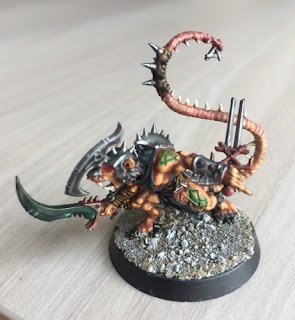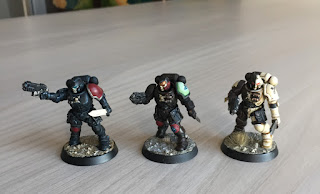Silver Tower is a set composed of two sides - heroes and minions of Tzeetch. And then, for some reason, there is the Skaven Deathrunner. It's just a random killing machine encounter, without any particular purpose within the story, but it's kind of cool.
I am no expert of Skaven and I can't find much about Deathrunners on the internet, so I made up some fluff for myself and my campaign. Maybe you can recycle it in some way for yours.
Assassins are the elite warriors of clan Eshin - over time, they have perfected the art of stealth and murder and none is more skilled in them save, perhaps, the Dark Elf Assassins of Naggaroth. Naturally, the path of the Assassin is not easy: not only becoming an Assassin requires talent and hard work and a trail of blood among rivals, but keeping the position also demands continued success in the tasks given by the Lords of the Clan.
The price for failure among Assassins is exceedingly high: it is said that once a Skaven Assassin is given a designated victim, one of the two must die. Going back home without completing a murder is not an option.
Still, sometimes it happens: this can be the result of genuine mistake by the Assassins, deeming the victim dead, or wilful lie: the Assassin might just think its target will never be found. But if the target is indeed found alive, the shame for the whole clan is great and the punishment for the Assassin exemplar.
This is usually the Deathrunner punishment: the Assassin is imprisoned and tortured extensively, until a new victim is designated, usually an archenemy of the Skaven. Few enemies are deemed worthy of a Deathrunner, so the period of imprisonment is generally long enough for the Skaven to go crazy and build a significant deathlust for anything that moves. When the victim is finally chosen, the prisoner is carved with tattoos and runes containing warpstone, giving him unholy powers: the horrible side effects of these rituals won't have time to develop, since a Deathrunner only has one mission in his life, and it's a suicide one. The prisoner is also fed with special potions giving him strength, quickness and resistance to pain normally impossible among regular Skaven: he grows larger during this time. His torture routine is coupled with images and stories about his target, causing him to identify him as the primary cause of his condition.
When the day comes, the Deathrunner is carried in proximity of his target in a closed cart, bound and blindfolded, and then equipped for war, drugged and released: thus starts his killing-spree. Most of the time his first victims are his jailers, but soon everything that moves follows. Still, the Deathrunner has only one thought: destroy his enemy. Anything standing in his path will be killed with a brutality only known by Rat-ogres, but coupled with an unnatural martial skill. Nothing survives the Deathrunner, not those who fight it, not those who run.
Once the target is dead, mauled and bitten to pieces, the Deathrunner is either killed by enemies or by the drugs he's been fed. Sometimes his heart will explode, other times he will die of exhaustion, and others he will just kill himself in his frenzy. So ends the life of the most fearsome warrior among the Ratkin.






































































